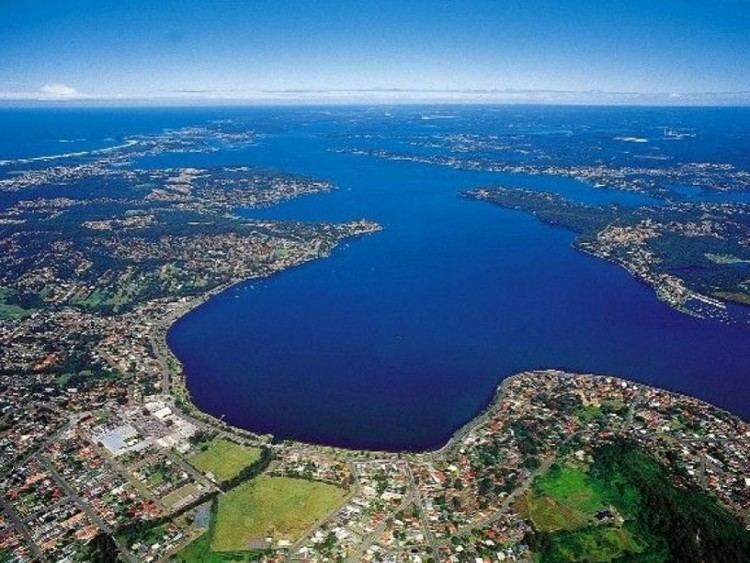Population 204,156 (2015) (21st) Mayor Kay Fraser Area 648 km² | Time zone AEST (UTC+10) Local time Monday 3:53 PM | |
 | ||
Established 1906 (shire)1977 (municipality)1984 (city) State electorate(s) Lake MacquarieSwanseaCharlestownCessnockWallsend Weather 24°C, Wind S at 31 km/h, 59% Humidity Points of interest Lake Macquarie, Belmont Bay, Raffertys Beach, Awaba Bay, Wangi Wangi Beach, Pebbly Beach, Pearl Beach | ||
The City of Lake Macquarie is a local government area in the Hunter region of New South Wales, Australia. The area is situated adjacent to the city of Newcastle and was proclaimed as a city from 7 September 1984. The city is approximately 150 km (93 mi) north of Sydney. One of its major tourist attractions is its lake, also named Lake Macquarie.
Contents
- Map of Lake Macquarie NSW 2283 Australia
- Fish hunt lake macquarie
- History
- Main towns and villages
- Demographics
- Economics
- Current composition and election method
- Shopping
- Arts and culture
- Sister cities
- References
Map of Lake Macquarie NSW 2283, Australia
The Mayor of the City of Lake Macquarie Council is Cr. Kay Fraser, a member of the Labor Party.
The Royal Australian Navy ship HMAS Tobruk (L 50) was granted Right of Freedom of Entry to the City of Lake Macquarie in 1991.
Fish hunt lake macquarie
History
The Shire of Lake Macquarie was proclaimed on 6 March 1906. It became a Municipality on 1 March 1977, and a city on 7 September 1984.
Main towns and villages
Lake Macquarie is home to several prominent coastal suburbs such as Catherine Hill Bay, Caves Beach, Blacksmiths Beach and Redhead. Retail centres include Belmont, Cardiff, Charlestown, Glendale, Swansea, Toronto, and Morisset with its large area and rapidly increasing developments.
Significant population centres include:
The various towns and suburbs are classified as being part of the Newcastle Statistical District, so their populations are included when Newcastle is commonly listed as Australia's sixth largest city. However, the City of Lake Macquarie has its own independent local government (Lake Macquarie City Council). The largest commercial centre in the region is Charlestown.
Demographics
The area is a set of contiguous towns that surround a coastal saltwater lake. These towns merge with the suburbs of Newcastle to the north. Some suburbs, such as Adamstown Heights are partly in the City of Newcastle and partly within the City of Lake Macquarie. There are 92 identified settlements ranging from small rural style communities through to larger and higher density areas such as Toronto, Warners Bay, Belmont, Charlestown and Morisset.
At the 2011 census, there were 189,006 people in the Lake Macquarie local government area, of these 48.8% were male and 51.2% were female. Aboriginal and Torres Strait Islander people made up 3.0% of the population, which was higher than the national and state averages. The median age of people in the City of Lake Macquarie was 41 years, which was significantly higher than the national median of 37 years. Children aged 0 – 14 years made up 18.6% of the population and people aged 65 years and over made up 18.4% of the population. Of people in the area aged 15 years and over, 51.0% were married and 12.2% were either divorced or separated.
Population growth in the City of Lake Macquarie between the 2001 census and the 2006 census was 3.36%; and in the subsequent five years to the 2011 Census, population growth was 3.20%. When compared with total population growth of Australia for the same periods, being 5.78% and 8.32% respectively, population growth in Lake Macquarie local government area was approximately half the national average. The median weekly income for residents within the City of Lake Macquarie was marginally below the national average.
At the 2011 Census, the proportion of residents in the Lake Macquarie local government area who stated their ancestry as Australian or Anglo-Saxon exceeded 81% of all residents (national average was 65.2%). In excess of 58% of all residents in the City of Lake Macquarie nominated a religious affiliation with Christianity at the 2011 census, which was slightly higher than the national average of 50.2%. Meanwhile, as at the census date, compared to the national average, households in the Lake Macquarie local government area had a significantly lower than average proportion (5.4%) where two or more languages are spoken (national average was 20.4%); and a significantly higher proportion (93.0%) where English only was spoken at home (national average was 76.8%).
Economics
Lake Macquarie has a significant coal mining industry and smaller agriculture and manufacturing industries. Eraring power station, a 1980s-era coal-fired power station, supplies 25% of New South Wales' power. Lake Macquarie has a number of Constructed Wetlands with the council placing an emphasis on the environment.
Current composition and election method
Lake Macquarie City Council is composed of thirteen Councillors, including the Mayor, for a fixed four-year term of office. The Mayor is directly elected while the twelve other Councillors are elected proportionally as three separate wards, each electing four Councillors. The most recent election was held on 8 September 2012, and the makeup of the Council, including the Mayor, is as follows:
The current Council, elected in 2012, in order of election by ward, is:
Shopping
Major shopping centres include:
Arts and culture
Lake Macquarie has a number of cultural and artistic locations:
Sister cities
The City of Lake Macquarie has sister city relations with the following cities:
